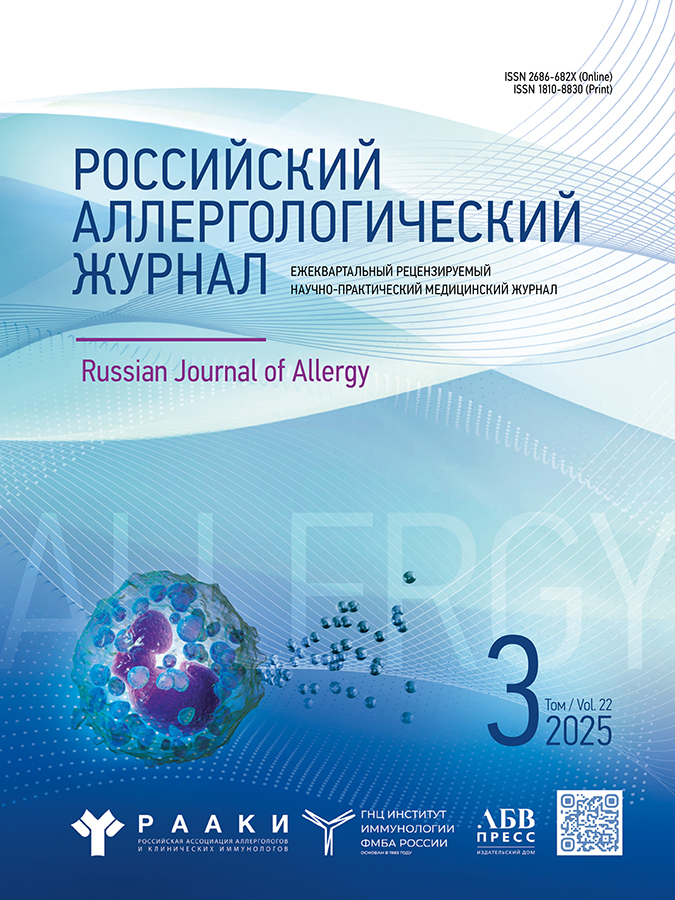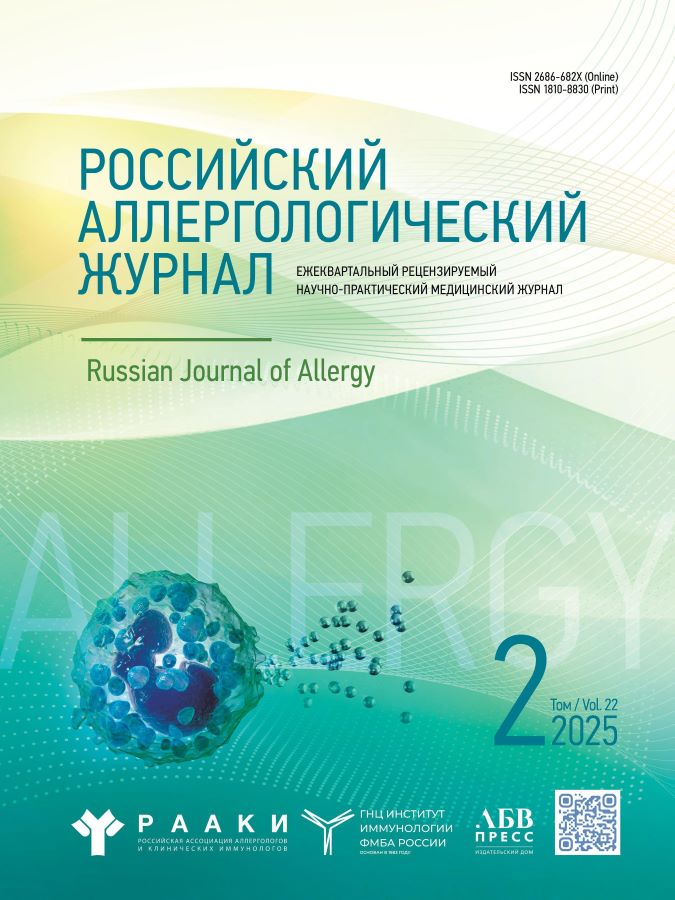Preclinical study of reproductive toxicity of a drug based on an aqueous solution of fullerene С60 for the treatment of food allergies
- Authors: Kovaleva E.V.1, Ivanova Y.V.1, Onatsky N.M.1, Shangaraeva V.A.1, Gorshenin D.S.2, Baraboshkina E.N.2, Galkina A.A.2, Bolyakina D.K.2, Parshina V.A.2, Kurmasheva R.A.2, Shershakova N.N.2, Mikhina L.V.1, Khaitov M.R.2,3
-
Affiliations:
- Research Center for Toxicology and Hygienic Regulation of Biological Products — Branch of the National Research Center — Institute of Immunology Federal Medico-Biological Agency
- National Research Center — Institute of Immunology Federal Medico-Biological Agency
- The Russian National Research Medical University named after N.I. Pirogov
- Issue: Vol 22, No 2 (2025)
- Pages: 153-164
- Section: Original studies
- Submitted: 06.12.2024
- Accepted: 18.03.2025
- Published: 03.06.2025
- URL: https://rusalljournal.ru/raj/article/view/16986
- DOI: https://doi.org/10.36691/RJA16986
- ID: 16986
Cite item
Abstract
BACKGROUND: The incidence of food allergy in adults and children is very high. The key approach in the therapy of food allergy can be quality drug selection. New synthetic derivatives of fullerene, a high-tech hydrocarbon, can become such drugs. A unique biocompatible method for obtaining a stable aqueous dispersion of fullerene C60 (ADF-C60) as the main component for drugs for the treatment of allergic diseases has been developed.
In this article, reproductive toxicity of the drug ADF-C60, currently in preclinical safety studies, was studied in female white outbred rats. Due to its properties, the ADF-C60 is promising for treatment of food allergy and can presumably be used during pregnancy.
AIM: Preclinical study of reproductive toxicity of an ADF-C60 in the antenatal and postnatal periods of rat offspring development with oral administration to the mother generation during pregnancy.
MATERIALS AND METHODS: Female rats were orally administered the ADF-C60 in 1-, 5-, and 50-fold therapeutic doses recommended for humans during the whole pregnancy. The general parameters of embryotoxic and teratogenic effects of the ADF-C60 before and after birth were studied.
RESULTS: No evidence of embryotoxic and teratogenic effects of the ADF-C60 was found during the study of gestational parameters and general fetuses development. No adverse effects of the ADF-C60 were revealed during observation of postnatal development of offspring.
CONCLUSION: ADF-C60 for the treatment of food allergy has no reproductive toxicity at doses up to 50 times higher than the therapeutic dose. After the conducted experiments it is possible to assume a significant probability of using the ADF-C60 during pregnancy, but additional preclinical and clinical studies are required to substantiate the obtained conclusion.
Full Text
About the authors
Elena V. Kovaleva
Research Center for Toxicology and Hygienic Regulation of Biological Products — Branch of the National Research Center — Institute of Immunology Federal Medico-Biological Agency
Author for correspondence.
Email: e-kovaleva@yandex.ru
ORCID iD: 0009-0003-8457-7391
SPIN-code: 2952-1038
Россия, Serpukhov
Yulia V. Ivanova
Research Center for Toxicology and Hygienic Regulation of Biological Products — Branch of the National Research Center — Institute of Immunology Federal Medico-Biological Agency
Email: ivanova-juliya@yandex.ru
ORCID iD: 0009-0009-1901-7244
SPIN-code: 5919-6840
Россия, Serpukhov
Nikolay M. Onatsky
Research Center for Toxicology and Hygienic Regulation of Biological Products — Branch of the National Research Center — Institute of Immunology Federal Medico-Biological Agency
Email: onatsky@toxicbio.ru
ORCID iD: 0009-0001-4826-7092
SPIN-code: 9404-4895
MD, Cand. Sci. (Biology)
Россия, SerpukhovVitaliia A. Shangaraeva
Research Center for Toxicology and Hygienic Regulation of Biological Products — Branch of the National Research Center — Institute of Immunology Federal Medico-Biological Agency
Email: vitaliyablik@gmail.com
ORCID iD: 0009-0005-4617-1141
SPIN-code: 7381-4940
MD, Cand. Sci. (Biology)
Россия, SerpukhovDenis S. Gorshenin
National Research Center — Institute of Immunology Federal Medico-Biological Agency
Email: dgorhenin63@gmail.com
ORCID iD: 0000-0002-1926-6090
SPIN-code: 5426-1810
Россия, Moscow
Elena N. Baraboshkina
National Research Center — Institute of Immunology Federal Medico-Biological Agency
Email: en.baraboshkina@nrcii.ru
ORCID iD: 0009-0002-0981-5540
SPIN-code: 3080-0926
MD, Cand. Sci. (Biology)
Россия, MoscowAnastasiia A. Galkina
National Research Center — Institute of Immunology Federal Medico-Biological Agency
Email: anastasia.a.galkina@gmail.com
ORCID iD: 0000-0003-4521-0813
SPIN-code: 7329-0197
Россия, Moscow
Darya K. Bolyakina
National Research Center — Institute of Immunology Federal Medico-Biological Agency
Email: bolyakina.dasha@gmail.com
ORCID iD: 0009-0006-2223-1514
SPIN-code: 4207-9481
Россия, Moscow
Veronika A. Parshina
National Research Center — Institute of Immunology Federal Medico-Biological Agency
Email: parshina.nicka@yandex.ru
ORCID iD: 0009-0001-7678-2489
SPIN-code: 1883-8361
Россия, Moscow
Renata A. Kurmasheva
National Research Center — Institute of Immunology Federal Medico-Biological Agency
Email: renata.adilevna@yandex.ru
ORCID iD: 0009-0003-8703-5686
SPIN-code: 2321-4718
Россия, Moscow
Nadezda N. Shershakova
National Research Center — Institute of Immunology Federal Medico-Biological Agency
Email: nn.shershakova@nrcii.ru
ORCID iD: 0000-0001-6444-6499
SPIN-code: 7555-5925
MD, Dr. Sci. (Biology)
Россия, MoscowLarisa V. Mikhina
Research Center for Toxicology and Hygienic Regulation of Biological Products — Branch of the National Research Center — Institute of Immunology Federal Medico-Biological Agency
Email: larisa_mihina@mail.ru
ORCID iD: 0000-0003-4931-5380
SPIN-code: 4040-9486
MD, Cand. Sci. (Biology)
Россия, SerpukhovMusa R. Khaitov
National Research Center — Institute of Immunology Federal Medico-Biological Agency; The Russian National Research Medical University named after N.I. Pirogov
Email: mr.khaitov@nrcii.ru
ORCID iD: 0000-0003-4961-9640
SPIN-code: 3199-9803
MD, Dr. Sci. (Medicine), Professor, corresponding member of Russian Academy of Sciences
Россия, Moscow; MoscowReferences
- Sidorovich OI, Luss LV. Food allergy principles of diagnosis and treatment. Medical Council. 2016;16:141–147. (In Russ.) doi: 10.21518/2079-701X-2016-16-141-147 EDN: WTOOZZ
- Балаболкин И.И. Пищевая аллергия у детей и подростков. Российский аллергологический журнал. 2006;3:44–52.
- Новик Г.А. Пищевая аллергия у детей раннего возраста. Лечащий врач. 2011;4:54–60. EDN: SGRFKX
- Loh W, Tang MLK. The epidemiology of food allergy in the global context. Int J Environ Res Public Health. 2018;15(9):2043. doi: 10.3390/ijerph15092043 EDN: SGPAIH
- Halken S, Muraro A, de Silva D, et al. EAACI guideline: preventing the development of food allergy in infants and young children (2020 update). Pediatr Allergy Immunol. 2021;32(5):843–858. doi: 10.1111/pai.13496 EDN: YLQDKD
- Prokopieva VD, Fedotova MM, Konovalova UV, et al. Prevalence and risk factors of food allergies in children: a review of epidemiological studies. Russian Journal of Allergy. 2022;19(2):175–189. (In Russ.) doi: 10.36691/RJA1531 EDN: TLVTGU
- Medzhidova MV, Abdullayeva NE, Fedorova NE, et al. Antiviral activity of amino acid derivatives of fullerene in cytomegalovirus infection in vitro. Antibiotics and Chemotherapy. 2004;49(8-9):13–20. (In Russ.) EDN: MQFJEN
- Lin YL, Lei HY, Luh TY, et al. Light-independent inactivation of dengue-2 virus by carboxyfullerene C3 isomer. Virology. 2000;275(2):258–262. doi: 10.1006/viro.2000.0490
- Tsao N, Luh TY, Chou CK, et al. In vitro action of carboxyfullerene. J Antimicrob Chemother. 2002;49(4):641–649. doi: 10.1093/jac/49.4.641 EDN: IQOPAB
- Tsao N, Luh T, Chou C, et al. Inhibition of group A streptococcus infection by carboxyfullerene. Antimicrob Agents Chemother. 2001;45(6):1788–1793. doi: 10.1128/AAC.45.6.1788-1793.2001
- Wang IC, Tai LA, Lee DD, et al. C60 and water-soluble fullerene derivatives as antioxidants against radical-initiated lipid peroxidation. J Med Chem. 1999;42(22):4614–4620. doi: 10.1021/jm990144s
- Li W, Li N, Sui B, Yang D. Anti-aging effect of fullerenol on skin aging through derived stem cells in a mouse model. Exp Ther Med. 2017;14(5):5045–5050. doi: 10.3892/etm.2017.5163
- Yang XL, Fan СH, Zhu HS. Photo-induced cytotoxicity of malonic acid C60 fullerene erivatives and its mechanism. Toxicol In Vitro. 2002;16(1):41–46. doi: 10.1016/s0887-2333(01)00102-3
- Dugan LL, Turetsky DM, Du C, et al. Carboxyfullerenes as neuroprotective agents. Proc Natl Acad Sci USA. 1997;94(17):9434–9439. doi: 10.1073/pnas.94.17.9434
- Пиотровский Л.Б. Фуллерены в дизайне лекарственных веществ. Российские нанотехнологии. 2007;2(7-8):6–18. EDN: IADHGF
- Sharoyko V, Shemchuk O, Meshcheriakov A, et al. Biocompatibility, antioxidant activity and collagen photoprotection properties of C60 fullerene adduct with L-methionine. Nanomedicine. 2022;40:102500. doi: 10.1016/j.nano.2021.102500 EDN: WOYHRZ
- Vesnina LE, Mamontova TV, Mikityuk MV, et al. The effect of fullerene C60 on the functional activity of phagocytic cells. Experimental and Clinical Pharmacology. 2011;74(6):26–29. (In Russ.) doi: 10.30906/0869-2092-2011-74-6-26-29 EDN: TNJZIF
- Andreev I, Petrukhina A, Garmanova A, et al. Penetration of fullerene C60 derivatives through biological membranes. Fullerenes, Nanotubes, and Carbon Nanostructures. 2008;16(2):89–102. doi: 10.1080/15363830701885831 EDN: LLJKIZ
- Bosi S, Da Ros T, Spalluto G, Prato M. Fullerene derivatives: an attractive tool for biological applications. Eur J Med Chem. 2003;38(11-12):913–923. doi: 10.1016/j.ejmech.2003.09.005
- Roursgaard M, Poulsen SS, Kepley CL, et al. Polyhydroxylated C60 fullerene (fullerenol) attenuates neutrophilic lung inflammation in mice. Basic Clin Pharmacol Toxicol. 2008;103(4):386–388. doi: 10.1111/j.1742-7843.2008.00315.x
- Deguchi Sh, Mukai SA. Top-down preparation of dispersions of C60 nanoparticles in organic solvents. Chem Lett. 2006;35(4):396–397. doi: 10.1246/cl.2006.396 EDN: XPDWYH
- Gupta SK, Dhawan A, Shanker R. In silico approaches: prediction of biological targets for fullerene derivatives. J Biomed Nanotech. 2011;7(1):91–92. doi: 10.1166/jbn.2011.1217
- Fujii-Kuriyama Y, Mimura J. Molecular mechanisms of AhR functions in the regulation of cytochrome P450 genes. Biochem Biophys Res Commun. 2005;338(1):311–317. doi: 10.1016/j.bbrc.2005.08.162
- Andreev S, Purgina D, Bashkatova E, et al. Study of fullerene aqueous dispersion prepared by novel dialysis method: simple way to fullerene aqueous solution. Fullerenes Nanotubes and Carbon Nanostructures. 2015;23(9):792–800. doi: 10.1080/1536383X.2014.998758 EDN: TWXIEX
- Gharbi N, Pressac M, Hadchouel M, et al. Fullerene is a powerful antioxidant in vivo with no acute or subacute toxicity. Nano Lett. 2005;5(12):2578–2585. doi: 10.1021/nl051866b EDN: LQQJGL
- Shershakova NN, Andreev SM, Tomchuk AA, et al. Wound healing activity of aqueous dispersion of fullerene C60 produced by “green technology”. Nanomedicine. 2023;47:102619. doi: 10.1016/j.nano.2022.102619 EDN: KUQAEO
- Shershakova N, Baraboshkina E, Andreev S, et al. Anti-inflammatory effect of fullerene C60 in a mice model of atopic dermatitis. J Nanobiotechnol. 2016;14:8. doi: 10.1186/s12951-016-0159-z EDN: VFVUPH
- Andreev SM, Bashkatova EN, Purgina DD, et al. Fullerenes: biomedical aspects. Immunologiya. 2015;36(1):57–61. (In Russ.) EDN: TNIIGP
- Руководство по проведению доклинических исследований лекарственных средств. Часть Первая / под ред. А.Н. Миронова, Н.Д. Бунятян, А.Н. Васильева, и др. Москва: Гриф и К, 2012. 944 с. ISBN: 978-5-8125-1466-3
- Руководство по содержанию и использованию лабораторных животных / под ред. И.В. Белозерцевой, М.С. Красильщиковой. 8-е изд. М.: ИРБИС, 2017. 336 с. ISBN: 978-5-9909917-0-5
- Kovaleva EV, Rybalkin SP, Shangaraeva VA, et al. Study of reproductive toxicity of the recombinant allergy vaccine for the treatment of allergy to birch pollen and cross-related allergens. Immunologiya. 2023;44(6):721–730. (In Russ.) doi: 10.33029/0206-4952-2023-44-6-721-730 EDN: HHPANS
- Halken S, Larenas-Linnemann D, Roberts G, et al. EAACI guidelines on allergen immunotherapy: prevention of allergy. Pediatr Allergy Immunol. 2017;28(8):728–745. doi: 10.1111/pai.12807
- Krishna SS, Farhana SA, TPA, et al. Modulation of immune response by nanoparticle-based immunotherapy against food allergens. Front Immunol. 2023;14:1229667. doi: 10.3389/fimmu.2023.1229667 EDN: PQLDRQ
- Ryan JJ, Bateman HR, Stover A, et al. Fullerene nanomaterials inhibit the allergic response. J Immunol. 2007;179(1):665–672. doi: 10.4049/jimmunol.179.1.665
- Шершакова Н.Н. Фуллерен C60: механизм биологической активности и разработка подходов к терапии заболеваний, связанных с окислительным стрессом: автореф. дис. … д-ра биол. наук: 3.2.7 — Иммунология. Москва: ФГБУ «ГНЦ «Институт иммунологии», 2024. 48 с. EDN: QCAGPV
- Takahashi M, Kato H, Doi Y, et al. Sub-acute oral toxicity study with fullerene C60 in rats. J Toxicol Sci. 2012;37(2):353–361. doi: 10.2131/jts.37.35338 EDN: PHPPST
- Чернух А.М., Александров П.Н. О тератогенном действии химических (лекарственных) веществ. Москва: Медицина, 1969. 176 с.
- Юшков Б.Г., Корнева Е.А., Черешнев В.А. Понятие нормы в физиологии и патологии. Физиологические константы лабораторных животных. Екатеринбург: УрО РАН, 2021. 864 с. ISBN: 978-5-7691-2542-3 EDN: XHQGVO
- Aliverti V, Bonanomi L, Giavini E, et al. The extent of fetal ossification as an index of delayed development in teratogenic studies on the rat. Teratology. 1979;20(2):237–242. doi: 10.1002/tera.1420200208
- Физические, биохимические и биометрические показатели нормы экспериментальных животных. Справочник / под ред. В.Г. Макарова, М.Н. Макаровой. Санкт-Петербург: Изд-во «Лема», 2013. 116 с. ISBN: 978-5-98709-619-2
- Guidance document on mammalian reproductive toxicity testing and assessment. OECD Environment, Health and Safety Publications. Series on Testing and Assessment [Internet]. 2008;43. Available from: https://www.oecd.org/en/publications/2008/07/guidance-document-on-mammalian-reproductive-toxicity-testing-and-assessment_02d2bf6d.html






